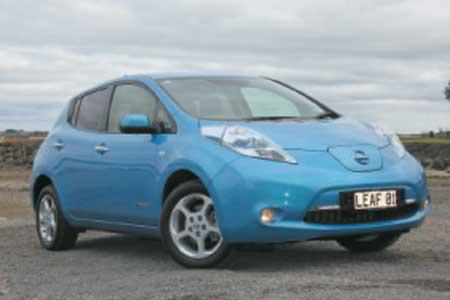| Nissan’s John Seymour calls it the “Leaf smile”. It’s what you get after about 15 minutes driving the Leaf electric car. When he told me, I looked at myself in the mirror, and sure enough, I had it! The Nissan Leaf is a pure plug-in electric vehicle. Unlike a hybrid, such as the Toyota Prius, it doesn’t have an internal combustion engine to recharge its batteries. The only way you can recharge a Leaf is by either plugging it into the mains, or a special recharging station. The Leaf is coming to New Zealand next year, but Motor Equipment News was privileged to get a special sneak preview drive, courtesy of Nissan NZ. And what an easy car to drive it is. The controls are simple, and to put it into drive you merely pull back on a ball-shaped device mounted where a gear lever would normally sit. One pull for normal drive, two pulls for economy, and a push for reverse. No gears. Driving it is akin to playing a computer game or sitting in a simulator. The absence of noise is partly the reason for this, as is the smoothness of its power delivery, and the lightness of the steering. With a load of lithium-ion batteries low down in the body, it feels well planted on the road, and has traction control, vehicle dynamic control (VDC) and electronic brake force distribution (EBD). Depending on how you drive it can be slow or quick. In economy acceleration is granny-like; in normal, when you floor the accelerator, you’re a teenager again. How you drive affects the range. Nissan says the Leaf will nominally travel 160km, but things such as temperature, terrain, extra cargo weight, and high speeds or aggressive driving will have a drastic effect on your actual range. But since the Leaf would probably be used for urban commuting, and most people don’t travel more than 80km a day, the range is more than adequate. Unlike an ordinary internal combustion engine the 80kW electric motor delivers its maximum torque from standstill so you literally bolt out of the stalls on take-off, and if you keep your foot down you can do 0-100 km/h in about 8.5 seconds. But most of the time you’ll opt for economy so battery levels will drop slowly, you’ll still keep up with the traffic in and around town, and you’ll top up the batteries each time you brake. From a styling viewpoint the Leaf suffers from the blandness that has crept into many Nissan mainstream designs such as the Tiida and Micra, but it’s better in the metal than in photos. Neat and clean would be generous. |
Inside, it’s modern, with a touch screen display to check up on state of the batteries, plus a digital speed display. And it’s roomier than you’d expect, with room for five and lots of load capacity because there’s no silencer/catalytic converter/fuel tank at the rear of the vehicle. |



